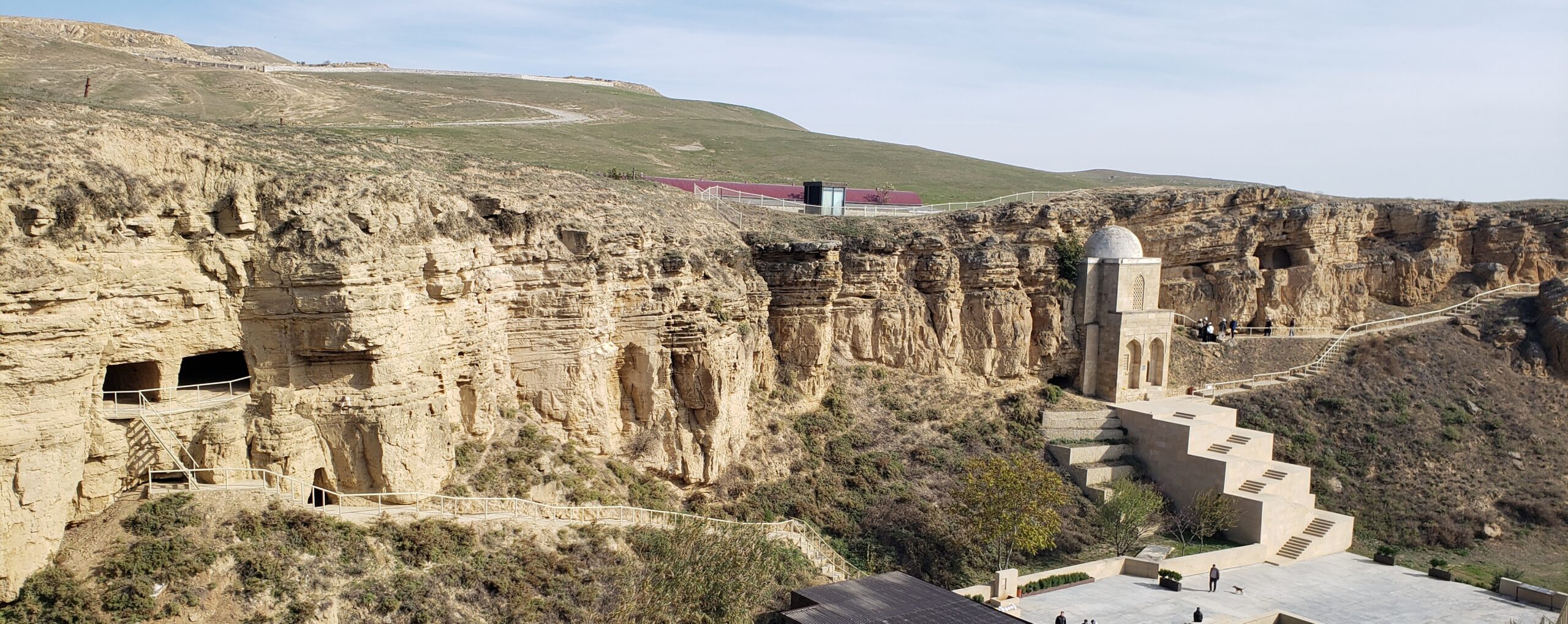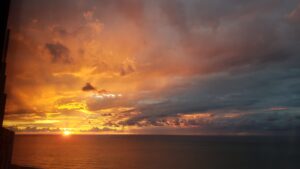In brief: Driving northward to the west of Azerbaijan’s Caucasus Mountains, we found high places and holy places, stony greys and vivid colors.
This was our second trip north. For our post about the eastern side, click here.
Shamakhi
For seven centuries, beginning with the advent of Islam through the 15th century, Shamakhi was the capital of the Shirvan shahs. During the next few hundred years, war and earthquakes devastated the imperial city. What remains to see, from the end of the Shirvan rule, are fascinating domed royal mausoleums and a mysterious, elegant tomb for a holy man. Aptly, in the city center, stands a huge mosque which, like the city, has repeatedly been a victim of earthquakes and conflict. But it’s been recently restored to contemporary splendor.
Diri Baba
The cave tomb of Sheikh Diri Baba is that elegant two-story domed façade on the sandstone cliff-face, located a bit south of Shamakhi. Its interior is carved into the rock. The origins of the tomb are mysterious, as is the identity of the entombed person. But its legends have made it a place of pilgrimage, attracting devotees that occupied the rough caves along the cliff and were often buried on the plateau where we took this photo. Non-pilgrims like us are required to wear hard hats to visit – a wise idea given the low clearances.
The interior of Diri Baba tomb with a jaali lattice screen in the center and tiles in the corners with floral designs, somewhat like the typical stalactite decoration of corners in Islamic architecture.
In the evocative cemetery across from Diri Baba’s tomb are these elaborately carved stone stele from the Middle Ages. Their designs show a lot of similarities, but are also quite varied, with calligraphic writings from Arabic and Persian texts as well as symbolic and floral decoration.
Tombs of Shirvan Shahs
In another cemetery high above Shamakhi, much less tended than Diri Baba’s, three domed mausoleums gleam in the sunlight. They were the burial sites for members of the ruling Shirvan clan. Each tomb contains three or four of those carved funeral stele. This tomb in the foreground has collapsed over time, but the stele still lean into each other with their vivid decoration. As we visited on a weekend, we also saw families tending the more recent burial sites of family members nearby.
One surprise inside the Shamakhi tombs was the color applied to the carved stone. We had no idea how recently they were painted, but thought that this had to be a common practice centuries ago.
Another surprise at the Shamakhi tombs was the very different iconography on the reverse side of these royal funeral markers. This one shows a mosque or tomb beneath which are various weapons and military supplies, as well as a riderless horse.
Juma Mosque
The Juma Mosque of Shamakhi originally dated from the 8th century at the beginning of Islam’s spread to the area. It was rebuilt in the 12th and 17th after conflicts, then several times in the 19th and 20th centuries after earthquakes, and finally once again a decade ago after another destructive war.
The harmonious and dazzling interior of the Juma Mosque.
Farther north and higher up
It’s often tough to get timing right in travel. Even in the “best” season, the vagaries of weather can alter plans and pleasures. We scheduled our three weeks in Azerbaijan in November because the other more mountainous countries of the Caucasus would turn cold and snowy by then.
So what would we find in Azerbaijan’s north, with its own mountainous region? Pure delight. The leaves of their deciduous forests had turned bright yellow, red, and orange. The tops of the mountains gleamed with snowy caps. The sun warmed us in cool temperatures. Even the cloudy days in the rough, medieval stone villages – rocky houses, rocky streets, rocky walls – seemed perfect, making those contrasting tinted hills even more vivid.
In November, the colorfully carpeted hills embrace the higher snow-capped mountains.
Nature’s color palette on the hills of Sheki
Medieval Kish
The mean streets of Kish were formed from river stones and lined with stone buildings and tiled roofs, whose origins date back to medieval times. It’s similar to the old center of Sheki, which replaced it as the Khan’s capital in the 18th century after destructive floods. Walking around makes you feel that you shifted back a millennium – minus the newer decorative doorways, stuccoed walls, and metal roofs. This was one of the wider lanes meandering up and down the hilly towns. Some of them can barely accommodate a modern vehicle. In the rain, the center channels fill with swiftly flowing water. We worried a bit about being swept downhill in a flood, as if the river stones wanted to return to their origin.
The so-called Albanian Church of Kish, on a hilltop in the neighbor town to Sheki. It’s one of the most important and revered of the early Christian churches in Muslim Azerbaijan.
Early in the spread of Christianity, it may have had a connection with Albanian disciples, but it’s more closely connected with the Armenian and Georgian sects.
The current building dates from the 11th and 12th centuries, replacing other Christian and cult religious structures some 300-plus years after Islam spread to Azerbaijan. To us, it demonstrated the continuing tolerance of other faiths here. We were told, for example, that downtown Baku is full of Christmas markets during December.
One of many fine artifacts in the church museum was this 7th century statue of Javanshir, purportedly the ruler of Caucasian Albania, displayed within the current Kish church along with several iron crosses.
Next to this brilliant little statue, you can read a very penitent and pleading prayer attributed to him. It ends as follows, “Deliver me from eternal temptations and in return for thy temple which I have built in Thy name on earth, prepare, O Christ, for me – a sinner – a spiritual abode in the mansion of Thy Father.”
Other artifacts displayed here date from the first centuries (BC and AD) when more pagan/cult religions occupied the hilltop site.
Tucked into the hillside along the woodsy outskirts of Kish, up another narrow stony lane, we found this attractive mosque. We discovered it because the PA system was blaring the call to prayer at high volume, though it seemed few people would gather here for that prayer service.
Old Sheki
We frequently discovered the old towns of the Caucasus as stops along the famous Silk Road of global trade. Caravanserei like this – or hostels – served the traveling salesmen and traders. The wealth of the Khans who ruled Sheki seems to have come from the silk itself, namely the breeding and trade in silk worms.
The UNESCO heritage site at Sheki is the Khan’s fortress, a large domain from the late 18th century still encircled by stone walls and towers. Most of the buildings within have not survived, victims of repeated mud floods. However, the often restored two-story summer palace at the center – actually an administrative building for the ruling Khans – is the true attraction. Here you can see from the outside the glorious floral decoration and the grillwork of the wooden windows. Regrettably, we could not view this facade from straight on in the garden because the windy conditions threatened to drop limbs onto us from the centuries-old plane tree there.
This is the “oh-wow” moment upon entering the Khan’s summer palace. From the inside, as sunlight passes through the tinted glass, the grillwork of the windows transforms into a kaleidoscope of color within an elaborate pattern – both through the window and the projection onto the floor. These “shebeke”windows, fitted from wooden pieces without glue or nails, have long been a local craft.
After that dazzle, it’s harder to focus on the even more spectacular fresco paintings covering every other wall. Floral designs in virtual vases, illustrations of birds, as well as decorative trim abound.
And then, on the second floor, there is a 15 meter (50 feet) narrative fresco about the defeat of the Persians, complete with huge assembled forces and lopped heads. We risked expulsion by sneaking even two photos.
(To enlarge any picture above, click on it. Also, for more pictures from Azerbaijan, CLICK HERE to view the slideshow at the end of the itinerary page.)























